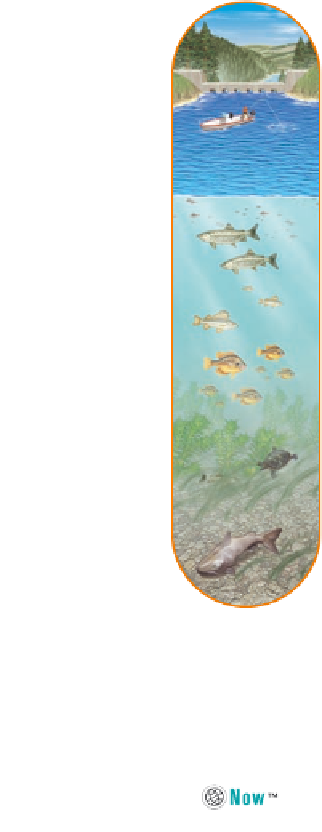Environmental Engineering Reference
In-Depth Information
5-7
FRESHWATER LIFE ZONES
Natural Capital
Freshwater Systems
Freshwater Life Zones
Freshwater ecosystems provide important ecological
and economic services even though they cover less
than 1% of the earth's surface.
Freshwater life zones
occur where water with a dis-
solved salt concentration of less than 1% by volume
accumulates on or flows through the surfaces of ter-
restrial biomes. Examples include
standing
(lentic)
bodies of fresh water such as lakes, ponds, and inland
wetlands and
flowing
(lotic) systems such as streams
and rivers. Although freshwater systems cover less
than 1% of the earth's surface, they provide a number
of important ecological and economic services (Fig-
ure 5-34).
Ecological
Services
Economic
Services
Climate
moderation
Food
Nutrient cycling
Drinking water
Waste treatment
and dilution
Irrigation water
Flood control
Hydroelectricity
Groundwater
recharge
Lakes: Water-Filled Depressions
Lakes consist of sunlit surface layers near and away
from the shore; at deeper levels, they contain a dark
layer and a bottom zone.
Lakes
are large natural bodies of standing fresh water
formed when precipitation, runoff, or groundwater
seepage fills depressions in the earth's surface. Causes
of such depressions include glaciation (the Great
Lakes of North America), crustal displacement (Lake
Nyasa in East Africa), and volcanic activity (Crater
Lake in Oregon). Lakes are supplied with water from
rainfall, melting snow, and streams that drain the sur-
rounding watershed.
Lakes normally consist of four distinct zones that
are defined by their depth and distance from shore
(Figure 5-35). The top layer, called the
littoral
(“LIT-
tore-el”)
zone,
consists of the shallow sunlit waters
near the shore to the depth at which rooted plants stop
growing. It has a high biological diversity.
Next is the
limnetic
(“lim-NET-ic”)
zone:
the open,
sunlit water surface layer away from the shore that
extends to the depth penetrated by sunlight. The
main photosynthetic body of the lake, it produces the
food
Habitats for
aquatic and
terrestrial
species
Transportation
corridors
Genetic
resources and
biodiversity
Recreation
Scientific
information
Employment
Figure 5-34
Natural capital:
major ecological and economic
services provided by freshwater systems.
Learn more about the zones of a lake, how its water turns
over between seasons, and how lakes differ below their sur-
faces at Environmental ScienceNow.
and
oxygen
that
support
most
of
the
lake's
Freshwater Streams and Rivers
Wa ter flowing from mountains to the sea creates
different aquatic conditions and habitats.
Precipitation that does not sink into the ground or
evaporate is
surface water.
It becomes
runoff
when it
flows into streams. The land area that delivers runoff,
sediment, and dissolved substances to a stream is
called a
watershed,
or
drainage basin.
Small streams
join to form rivers, and rivers flow downhill to the
ocean (Figure 5-36, p. 106).
In many areas, streams begin in mountainous or
hilly areas that collect and release water falling to the
consumers.
Next comes the
profundal
(“pro-FUN-dahl”)
zone:
the deep, open water where it is too dark for photo-
synthesis. Without sunlight and plants, oxygen levels
are low here. Fish adapted to the lake's cooler and
darker water are found in this zone.
Finally, the bottom of the lake contains the
benthic
(“BEN-thic”)
zone.
Mostly decomposers, detritus feed-
ers, and fish that swim from one zone to the other
inhabit it. The benthic zone is nourished mainly by de-
tritus that falls from the littoral and limnetic zones and
by sediment washing into the lake.







